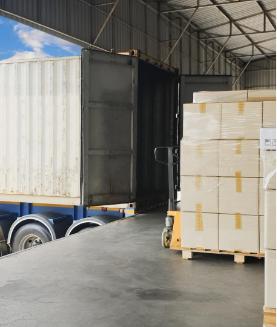
Outbound logistics focuses on the distribution of your products. It includes warehousing, processing and transporting your goods to your customer. It also entails communications with both the customers and the freight carriers. On the surface, this doesn't sound too complicated. However, once you become involved in the daily management of this end of a business, it can be pretty involved, expensive and stressful. The way you handle this end of your business can have a substantial impact on your bottom line. Knowing how to manage your resources and personnel can save time, money and keep your clients satisfied.
Outbound Logistics BasicsAt the delivery end of your production, you have to deal with storing your products until they're sold and ready to be delivered. Warehousing, staff, utilities and equipment are huge expenses, so minimal storage time lessens the storage costs you associate with your product. Transporting your goods is a variable that fluctuates if you don't have your own dedicated transportation team. Fuel costs can vary from hour to hour. You're at the mercy and whims of the cartage companies with whom you deal. The distance your products will be transported to your various customers also differs. This is another fluctuating expense.
Communications is very important to this phase of your business. Schedules must be current, and warehouse staff and transportation personnel need to be aware of scheduling changes at all times. Your customers also require attention. This is not only for his own facility's scheduling, but it's necessary for your company to maintain a strong customer service presence and preserve the reliability on which your customers count.
Tips for Improved Supply Chain ManagementManagement improvements that are implemented to reduce expenses are often the very things that result in more efficient service and increased customer satisfaction. Refining your supply chain management strategy is a win-win move for both you and your clients.
- To ensure the most cost-effective means of shipping your product, maintain a current rate profile of all your possible carriers. This allows you to provide accurate figures during the quote and order entry process. If you need more than one type of transportation for delivering your products, some companies offer comprehensive solutions. Dealing with a single shipping company streamlines your paperwork and communications and results in a more efficient delivery system. However, do your research to ensure that you're getting the best possible rates for each type of service.
- Plan your finished product inventory wisely. Reducing your inventory and the associated costs adds to your net profit. Use your company's selling history to forecast your seasonal inventory requirements.
- Incorporating supply chain management software into your operation allows a business to match supply side manufacturing with customer demand. This means you'll be able to maintain low inventory levels and still meet customer demand. It also provides for timely fulfillment and minimizes out-of-stock situations.
- This type of software is also capable of performing all your accounting tasks. It can generate customized forms and invoices for individual customers, and it can provide electronic messaging all along the supply chain process to keep your customers apprised of any scheduling or product changes.
- Develop a strategy and review it regularly. Your supply chain is continually evolving and fluctuating, and a stagnant strategy is a sure way to lose efficiency, profits and customers. Flexibility and the ability to change or adapt your logistics strategy is important to keep your customer service at a maximum level and to keep your costs at a minimum.
A small business may have a less complex supply chain, but its success requires the same commitment and attention to detail as a Fortune 500 company. Whether you have a dedicated management team or are a company of one, you need to give careful consideration to the way in which you warehouse, manage and ship your products. Your customers deserve the same concern and attention whether their orders are for a single item or a truckload.
Planning and optimizing the way your company handles its product production, delivery and customer interaction is an integral part of planning for your company's success.







